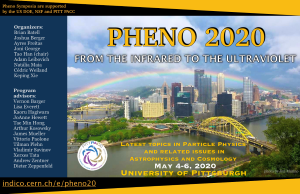Speaker
Description
The notion of stringy naturalness-- that an observable $O_2$ is more natural than $O_1$ if more (phenomenologically acceptable) vacua solutions lead to
$O_2$ rather than $O_1$-- is examined within the context of the Standard Model (SM) and various SUSY extensions: CMSSM/mSUGRA, high-scale SUSY and radiatively-driven natural SUSY (RNS). Rather general arguments from string theory suggest a (possibly mild) statistical draw towards vacua with large soft SUSY breaking terms. These vacua must be tempered by an anthropic veto of non-standard vacua or vacua with too large a value of the weak scale $m(weak)$. We argue that the SM, the CMSSM and the various high-scale SUSY models are all expected to be relatively rare occurrences within the string theory landscape of vacua. In contrast, models with TeV-scale soft terms but with $m(weak)$ ~ $100$ GeV and consequent light higgsinos (SUSY with radiatively-driven naturalness) should be much more common on the landscape. These latter models have a statistical preference for $m_h$ ~ $125$ GeV and strongly interacting sparticles beyond current LHC reach. Thus, while conventional naturalness favors sparticles close to the weak scale, stringy naturalness favors sparticles so heavy that electroweak symmetry is barely broken and one is living dangerously close to vacua with charge-or-color breaking minima, no electroweak breaking or pocket universe weak scale values too far from our measured value. Expectations for how landscape SUSY would manifest itself at collider and dark matter search experiments are then modified compared to usual notions.
